Key takeaways:
- Effective donation logistics are crucial for timely and respectful delivery of resources to those in need, enhancing the emotional connection between donors and recipients.
- Flexibility and clear communication are essential to overcoming challenges in donation logistics, allowing organizations to adapt to unexpected situations and improve collaboration.
- Building strong partnerships with local organizations amplifies impact, providing valuable insights and resources that improve donation efficiency.
- Each donation carries a story and personal significance, emphasizing the importance of recognizing the human aspect behind charitable efforts.
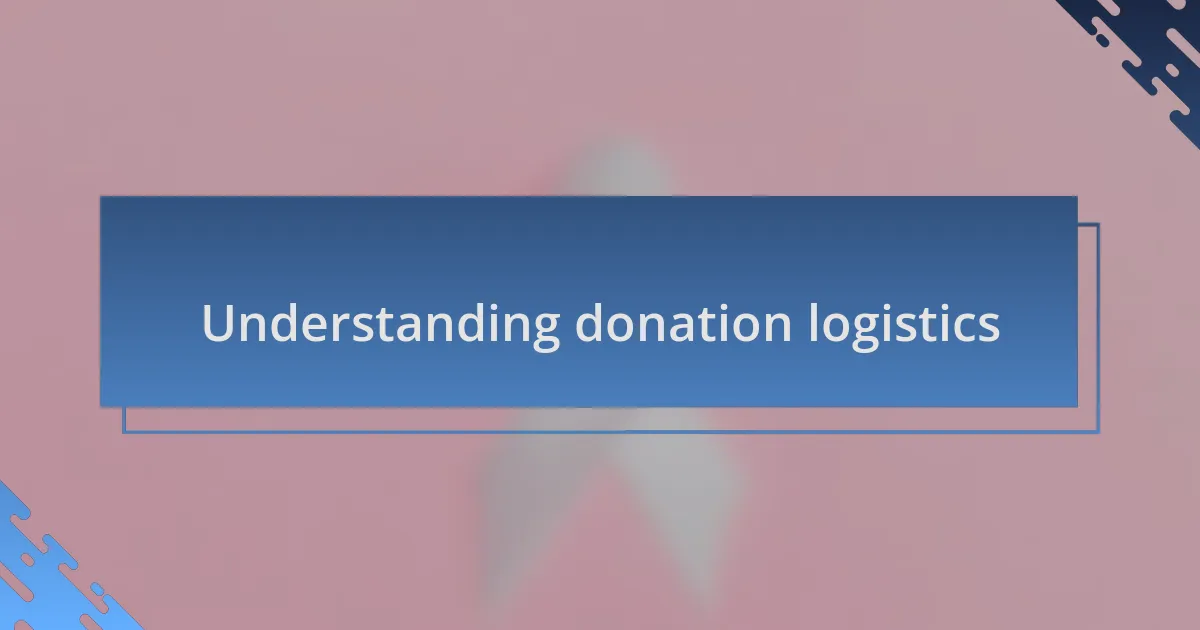
Understanding donation logistics
Understanding donation logistics is crucial, especially in a charity focused on assisting the homeless. From my experience, I learned that the process starts with effectively matching the needs of those we serve with the resources available. I still remember the first time I had to sort through a mountain of donations; it was overwhelming, but it lit a fire in my commitment to streamline the process.
The logistics of donations isn’t just about physical items; it’s about creating a seamless flow from donor to recipient. I often found myself thinking, what happens if the items donated never reach those in need? I recall a situation where we received a large shipment of winter coats, but the delivery time was off, and the city’s cold snap arrived first. It was a lesson in the importance of timing and organization that I won’t forget.
We also need to consider the emotional side of donation logistics. I remember the joy on the faces of families receiving essential supplies, and I realized it comes down to more than just delivering items; it’s about ensuring dignity and respect in the process. How do we ensure that this emotional connection remains strong? I’ve learned that efficient logistics can enhance that connection, allowing us to focus not just on what we deliver, but how we deliver it.
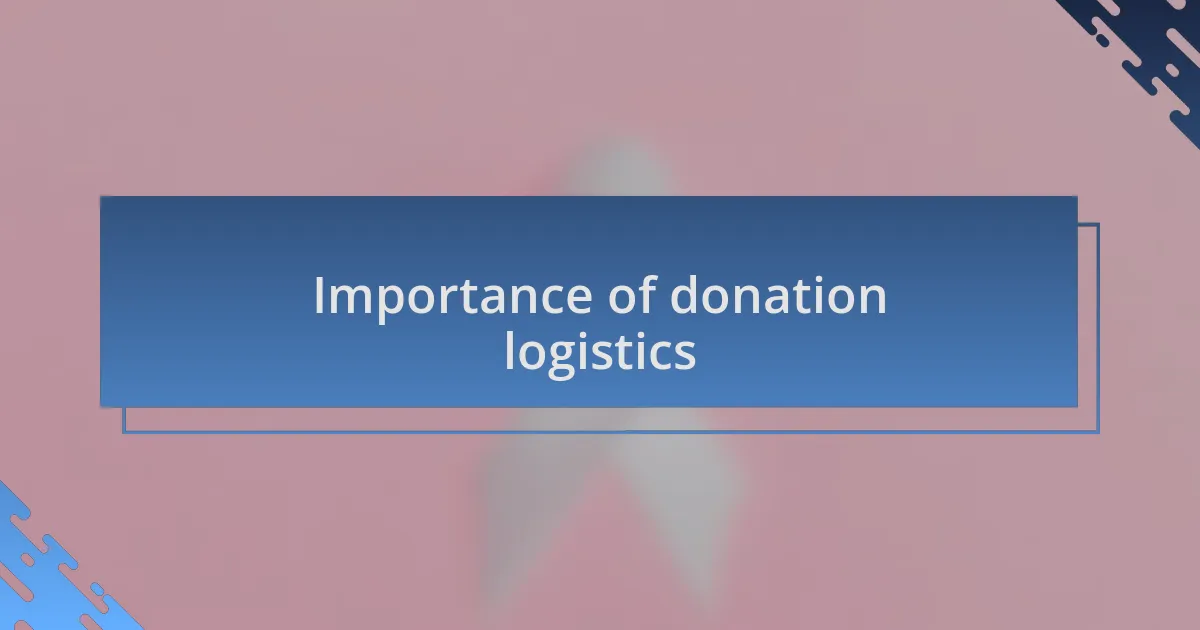
Importance of donation logistics
Effective donation logistics play a pivotal role in ensuring resources reach those who need them. I vividly remember a time when we received a last-minute collection of blankets before a severe cold spell. The excitement to distribute these blankets quickly was palpable, but it made me realize the urgency and organization required in every step. If we hadn’t streamlined our logistics, those blankets might have gone to waste rather than providing warmth to those in desperate need.
I often reflect on the ripple effect that efficient donation logistics can create. There was an instance when we organized a large food drive, and thanks to a meticulous planning process, we were able to feed a hundred families in just a few hours. The gratitude I witnessed on that day solidified my belief: clear logistics don’t just ensure delivery; they amplify our impact, allowing us to maximize the support we offer.
Moreover, logistics are not merely a back-end function; they are the heartbeat of a charitable organization. I once saw a volunteer struggle with distributing items, overwhelmed by the amount, and it struck me that our logistical approach directly affected their morale. How can we inspire our team if the systems in place are chaotic? By prioritizing donation logistics, we create an empowered environment to serve those in need, fostering compassion and community.
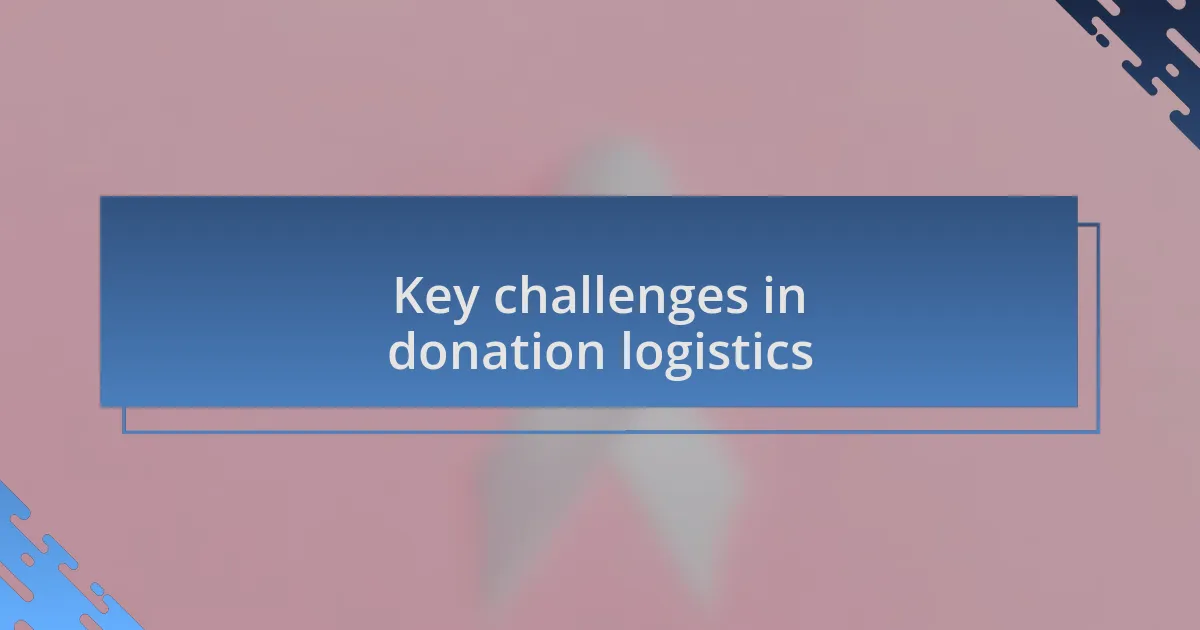
Key challenges in donation logistics
One of the key challenges in donation logistics revolves around coordination and communication. I recall a situation where we had a surplus of clothing donations but struggled to get them to the right shelter in time. It was frustrating to see perfectly good items get stuck in transit while those in need were still left without adequate clothing. How often do we underestimate the power of timely communication?
Another significant hurdle is the unpredictable nature of donations themselves. I remember a colleague who planned a distribution day for food but was blindsided when half of the expected supplies didn’t arrive. It was heart-wrenching to adjust our plans at the last minute, leaving us scrambling to fill the gaps. This taught me that flexibility is just as important as planning; we need to be ready to pivot and adapt to the unexpected.
Finally, resource allocation can be a complex puzzle in donation logistics. There have been times when we had ample volunteers but limited vehicles to transport goods. It left me pondering: how can we maximize our human resources if we can’t move the donations effectively? Finding a synergy between people, equipment, and time is crucial to overcoming these logistical obstacles and truly making an impact.
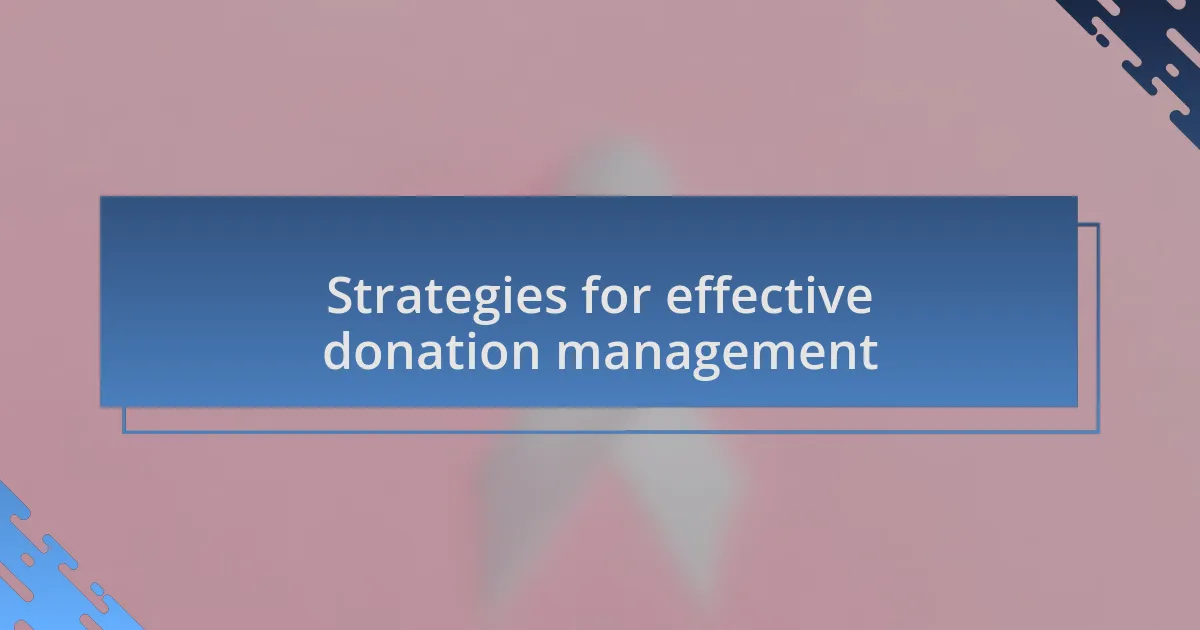
Strategies for effective donation management
Effective donation management requires a proactive approach to inventory tracking. I often found success using a simple spreadsheet or app that keeps tabs on what we have, what we need, and where everything is. Imagine the relief of knowing exactly what to distribute on any given day, preventing mishaps and ensuring no valuable donations get overlooked.
Collaborating with local businesses is another strategy that can boost donation efficiency. I recall partnering with a grocery store that allowed us to pick up unsold items daily. This not only provided us with a reliable food source but also strengthened community ties. Isn’t it remarkable how fostering relationships can create a win-win situation for everyone involved?
Lastly, establishing a clear donation process for contributors makes a world of difference. I remember crafting a detailed guide for donors, laying out what items we accepted and the best times for drop-offs. This clarity helped streamline operations and minimized the confusion that often arises when donations flood in unexpectedly. How have you managed to communicate effectively with donors in your experiences?
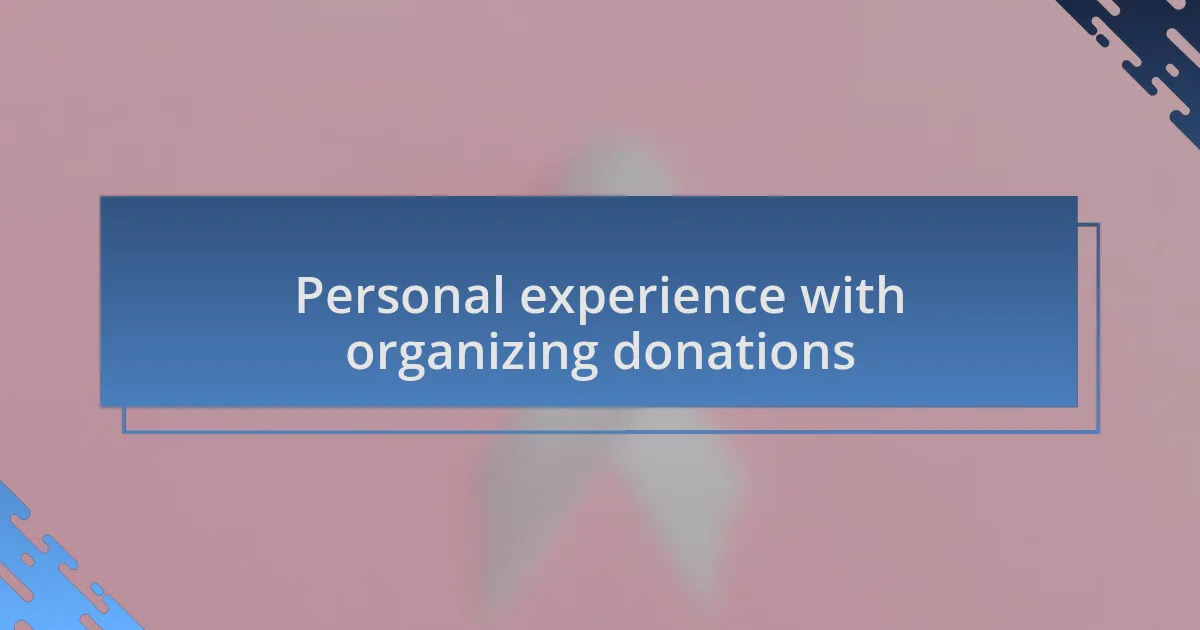
Personal experience with organizing donations
Organizing donations has been a journey filled with learning and growth for me. One day, I found myself surrounded by stacks of clothing donations that were far more than we anticipated. It struck me how overwhelming generosity can be, but I realized we needed a structured sorting process to channel that kindness effectively. This experience emphasized the importance of managing expectations, both for our team and the donors.
During another event, we organized a large drive where the community came together to contribute. I can vividly recall the joy on the faces of volunteers when we filled an entire room with blankets and warm clothes for those in need. It was awe-inspiring to see this collective effort, and it reminded me that donations are not just items; they carry stories and emotions that deserve to be acknowledged and honored.
One of the most rewarding aspects I’ve encountered is ensuring that each item distributed speaks to someone’s specific need. I remember a time when we had a surplus of children’s toys, and instead of letting them sit idle, we created a special giveaway day just for families in shelters. Watching children light up with joy was a powerful reminder of why we do this work. How do you ensure that each donation reaches the right hands in your experience?
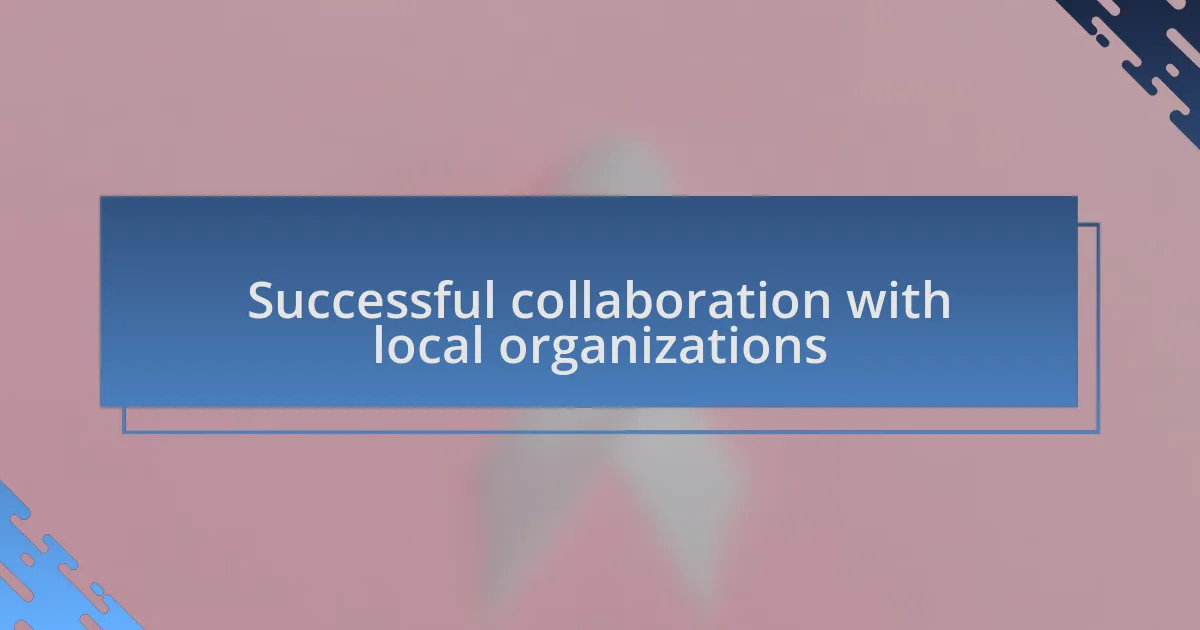
Successful collaboration with local organizations
Successful collaboration with local organizations can make a significant difference in the efficiency of donation logistics. I remember partnering with a local food bank for a winter coat drive. Their established network allowed us to reach families in need quickly, which not only empowered our mission but also fostered genuine relationships between our organizations. Isn’t it amazing how working together can multiply our impact?
In another instance, we teamed up with a nearby shelter to organize a distribution event. They provided invaluable insights into the needs of their clients, which informed our donation gathering efforts. I was struck by the sincerity of the volunteers from both organizations. Seeing everyone united under a shared vision was a beautiful reminder of why collaboration is essential in charitable endeavors.
I often reflect on how these partnerships turned challenges into opportunities. During one particularly hectic week, unforeseen logistical issues arose. Fortunately, a local church stepped in to help transport our donations. Their willingness to assist not only eased our burden but also highlighted the incredible spirit of community. How often do we overlook the strength that comes from uniting with others for a common cause?

Lessons learned during donation efforts
Navigating donation logistics taught me the importance of flexibility. I vividly remember a day when a scheduled pickup fell through last minute. Instead of panicking, I reached out to volunteers, and we quickly reorganized our plans. This experience made me realize that adaptability can turn potential setbacks into opportunities for creative solutions. How often do we underestimate our ability to pivot in face of challenges?
Another key lesson has been the power of clear communication. During a large clothing drive, I noticed that some items were being delivered to the wrong locations, leading to frustration among our team. After addressing this with everyone involved, we established a shared communication platform. This not only solved the immediate issue but also enhanced collaboration moving forward. Have you ever experienced how clarity can bring a chaotic environment into harmony?
Finally, I learned that building relationships with donors is just as vital as logistics. I distinctly recall a heartfelt conversation with a generous contributor who shared their personal story about homelessness. That moment deepened my understanding of the human aspect behind donations. I believe it’s crucial to remember that every item donated represents a life touched, and fostering these connections makes the process more meaningful. Don’t you think it’s essential to recognize the stories behind the donations?